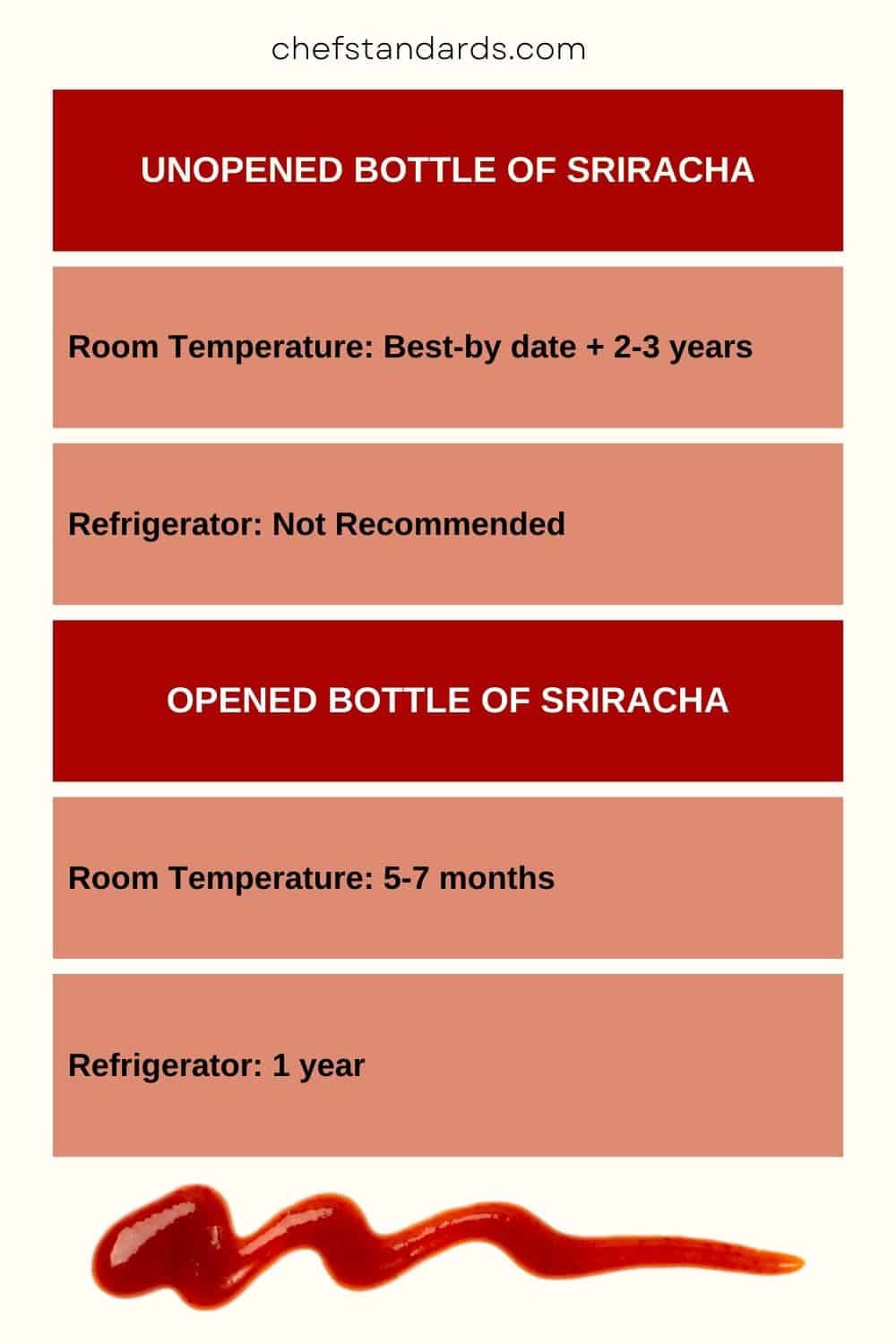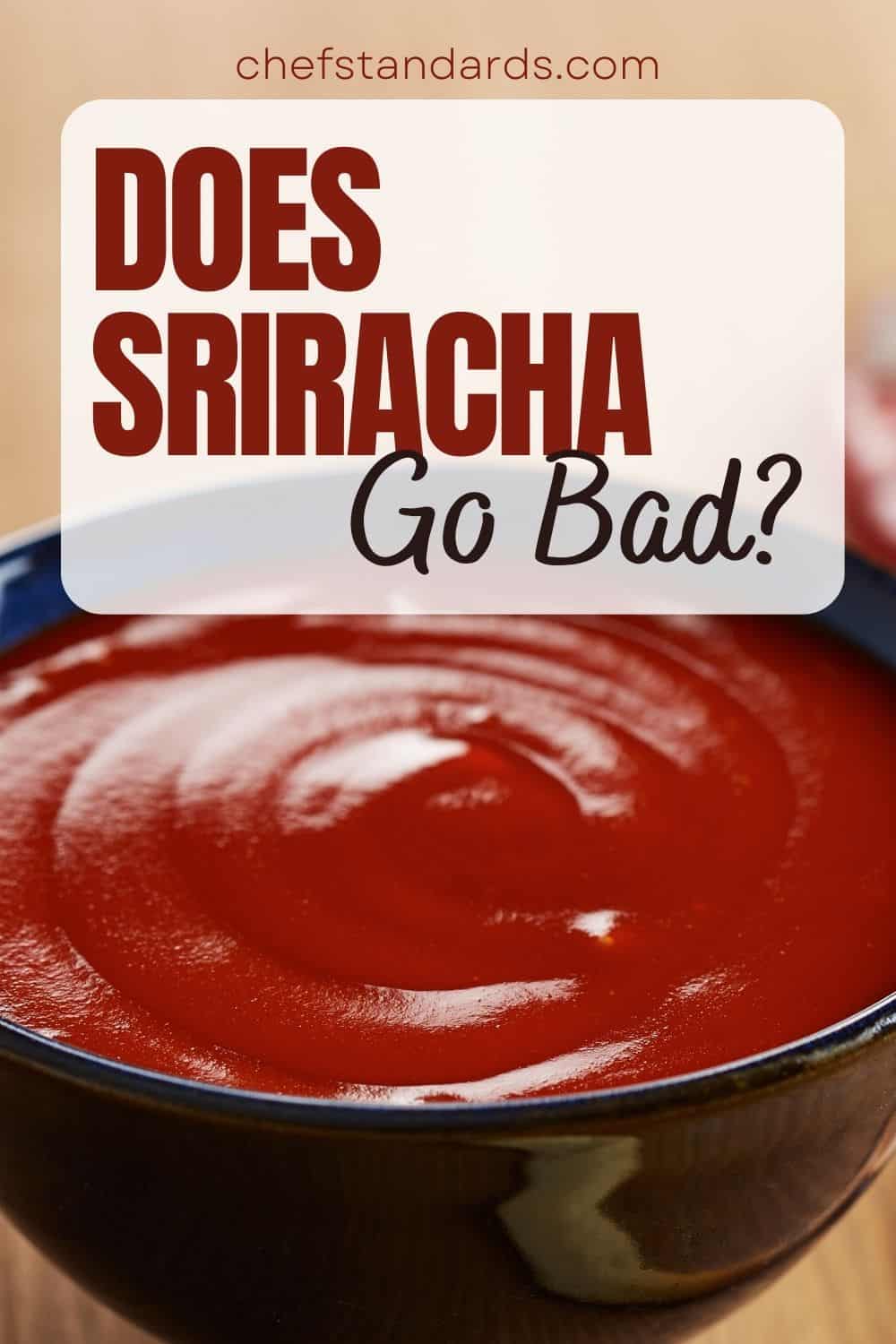You don’t have to be a fan of hot and spicy foods to love hot sauce like Sriracha. The combination of sweet and tangy flavors with a noticeable heat level can bring out the best of almost every dish.
I am a fan of Mexican cuisine and I use it a lot and always have a few bottles in the kitchen.
In most cases, those bottles are empty after just a few days, but sometimes there happens to be one or two bottles still left.
The question about spoilage then arises because every single bottle of this incredible sauce is valuable.
So, does Sriracha go bad? Well, sriracha can go bad, but fortunately that won’t happen very easily.
If you continue reading, you will find out what I am talking about.
Sriracha and Spoilage

Sriracha can spoil, but the great thing is that, out of all types of sauces, it is the most shelf-stable. So, if you buy a package of sriracha and don’t use it for a long time, you really have to make bad moves for it to spoil.
The main reason for this is the ingredients in the sauce. Namely, the two main ingredients are vinegar and chili peppers. Vinegar is known as a natural ingredient for food preservation and it helps keep canned and jarred foods safe to eat for a very long time.
On the other hand, hot peppers are also very shelf-stable due to the presence of the natural compound known as capsaicin that gives it a recognizable spicy flavor.
Other ingredients that contribute to this include salt and sugar, as well as some additives that are also very important for the shelf life of sriracha sauce.
And then there is the pH level, which is relatively low in sriracha, and it helps inhibit the growth of bacteria and microorganisms that can cause spoilage. (1)
However, other factors like packaging, potential contamination, and storage conditions also play a huge role, and can potentially contribute to spoilage if you don’t handle and store it properly.
So, before I explain about the best storage practices, I will briefly go through a few potential spoilage signs you need to be aware of.
Also, take a look at how sriracha is made.

How To Tell If Sriracha Is Bad?
Because Sriracha contains ingredients that are great at preserving foods, it won’t go bad in the traditional way, i.e. in a way that will make you really sick because of harmful bacteria, but there are some signs of spoilage to look for.
1. Appearance of Mold: It is very rare that mold develops in Sriracha, but it can happen,so it is important to be careful. If you see any little gray, greenish, or black spots in your sriracha, it is best to toss it.
2. Texture Changes: Pay attention to any changes in the texture of sriracha sauce. Spoiled sauce may develop a thick, slimy, or clumpy consistency.
The separation of liquid and solids, or the presence of mold growth on the surface, is also a sign of spoilage. Fresh sriracha sauce should have a smooth, uniform texture.
3. Bad Odor: Sriracha sauce typically has a pungent, spicy aroma due to the presence of chili peppers and garlic. If the sauce develops an off odor, such as a sour, rotten, or fermented smell, it is a strong indication of spoilage.
The presence of unpleasant or foul odors suggests the growth of spoilage-causing microorganisms.
4. Gas Production: In some cases, spoiled sriracha sauce can produce gas due to the fermentation of sugars present in the sauce.
If you notice any signs of bloating or gas formation in the container, or a “fizzy” sensation when opening the bottle, it suggests that the sauce has undergone fermentation and is no longer safe to consume.
5. Unusual Taste: If you don’t notice any of these signs, your sriracha is most likely still good for consumption. However, if you want to be 100% sure, it is not a bad idea to taste it just a little bit.
Good sriracha has a distinct, tangy, and spicy taste. If you notice any significant changes in the taste, such as a sour or bitter flavor, it may indicate spoilage.
One more note. Sriracha changes color over time, but a different color doesn’t indicate spoilage. It is merely the natural process in which chili peppers become darker and a bit spicier as well.
How Long Does It Really Last?

The only thing that’s for sure is the fact that Sriracha has a really long shelf life, of course, if handled and stored properly.
Once you buy a bottle of sriracha, it will stay good in the pantry for a few years. However, many people tend to be concerned about “expiration date” on the label.
Well, it is actually “best-by date” that indicates a time in which the product will retain its best quality. So, even if it stays in the pantry 2-3 years after that date, it will still be safe for eating.
However, once you open the bottle, it is best to consume it within 5-7 months if you are planning to leave it in the pantry. This does not mean that it will make you sick after that time frame, but the quality will most likely deteriorate rapidly.
Fortunately, there is also a solution if you want to prolong that time frame. You can put an opened bottle of sriracha in the fridge and it will stay good for up to a year.
How To Store It Properly?
Sriracha won’t spoil as quickly as salsa, but it is certainly important to know how to store it properly.
So, if you are dealing with an unopened bottle of sriracha, it is best to store it in a cool, dry place, away from direct sunlight and heat sources.
Fluctuations in temperature can degrade the quality of sauce, so it is essential to avoid storing it in areas prone to temperature extremes, such as near an oven or stovetop.
Finally, make sure that the cap or lid of the sriracha bottle is tightly sealed to prevent air and moisture from entering, which can accelerate spoilage.
Once you open the bottle, you can follow these instructions as well, but you have to know that the quality of the sauce will deteriorate more quickly. My recommendation is to store it in the fridge instead.
You can just put the bottle in the fridge and ensure that it is sealed tightly. But it is even better to transfer it to a smaller airtight container if there is a lot of space left in the bottle.
Namely, if there is a significant amount of empty space in the bottle after opening, there is a significant amount of oxygen as well. And oxygen can degrade the quality of the sauce.
Finally, ensure that the container is tightly sealed to prevent moisture from entering and label the container with the date of opening. This will help you track its shelf life and avoid consuming sauce that has expired.
Can It Be Frozen For Longer Storage?
Although you can technically put your sriracha in the freezer, I really wouldn’t recommend that.
The reason is that there won’t be any significant changes in its shelf life and the quality might easily degrade in the freezer.
The water content in the sauce can crystallize, leading to a watery or grainy texture when thawed. Upon thawing, the sauce may become thinner and lose its original consistency.
There is also flavor loss, i.e. the freezing process can cause the flavors to become less vibrant, resulting in a milder taste compared to the taste of a fresh sauce.
Finally, you can cause some damage as well. Freezing Sriracha sauce in its original bottle can pose a risk of the container cracking or breaking due to the expansion of the liquid as it freezes, especially if the bottle is made from glass.
Based on all this information, freezing is definitely not a suitable option.
Conclusion
So does sriracha go bad? It certainly does, but if you handle and store it the right way, it can retain its quality for years due to the preserving and shelf-stable ingredients.
It likes cool and dry environments and it is not a fan of high heat and moisture, so you just need to keep that in mind when adjusting storage conditions.
Sources:
1. National Library of Medicine (2020), Microorganisms Response to Acid pH, accessed 2 June 2023


